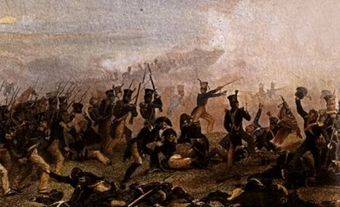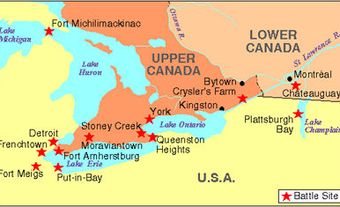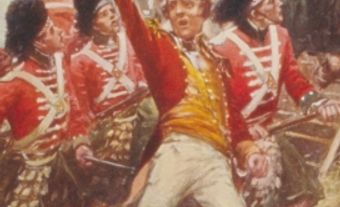War on the Lakes in the War of 1812
The North American heartland, linked by rivers running from the north, west, and south and flowing eastwards via the St Lawrence River, saw intense fighting during the War of 1812. Homeland to numerous Aboriginal peoples, the Great Lakes constituted a middle ground and was at the same time the place of interaction with the powers seeking to control this heartland - the United States and the British Empire. At issue were matters of immense importance to the survival of Upper and Lower Canada, and to the prospect of a future federation of British North America. Upon the outcome depended the Canadian fur trade. Waging war on the British side depended on several factors: units of naval power, notably on Lakes Ontario, Erie and Huron; supplies and armaments coming via the St Lawrence or the Ottawa River route to Georgian Bay; and the fragile alliance with Aboriginal peoples (see First Nations in the War of 1812).
1812 - Early Months of the War
To protect the British flank in the Ohio country, Major-General Isaac Brock, commanding military forces in Upper Canada, developed a strategy of the initiative. The best means of defence of the exposed Upper Canada peninsula was to attack Detroit and Fort Michilimackinac, and to invade western Ohio. Brock took Detroit on 16 August 1812, and he did so without a shot. With Fort Detroit and the Provincial Marine at Fort Amherstburg (see Fort Malden), downriver near Lake Erie, the British had secured a water-based supply route from Fort Erie. From Fort St Joseph on Lake Huron, Captain Charles Roberts with a mixed force obliged the defender of Michilimackinac, Lieutenant Porter Hanks, to capitulate on 17 July 1812 (see Battle of Mackinac Island). That "Gibraltar of the Straits" was kept by the British for the duration of the war.
After Michilimackinac was captured, the Americans evacuated Fort Dearborn [Chicago] on Lake Michigan only to be slaughtered in an ambush. On Lake Erie, the first months of the war had gone decidedly in Britain's favour, except for the American capture of one ship and the burning of another near Fort Erie on 9 October. On Lake Ontario, the British built up their capacities at the naval yard and garrison at Kingston. On the American side, at Sackets Harbor, the Americans built a well-defended naval yard, and they had a smaller shipbuilding facility at Black Creek on the Niagara River [near Buffalo, NY] as well.
1813 Campaigning Season
Commodore Isaac Chauncey, commanding US naval units on Lake Ontario, decided that if the command of Lake Erie were to be acquired then a new base would have to be built west of precarious Black Rock, which was within the range of the guns at Fort Erie. Presque Isle [Erie, Pennsylvania] was selected and here a fleet was built that would fight in the Battle of Lake Erie, 10 September 1813, against a British force of warships under Commodore Robert Heriot Barclay. Commodore Oliver Hazard Perry, the victor, thereby acquired for the Americans all the advantages of a decisive sea victory: he obliged British army units in Ohio, now under command of Major General Henry Procter, to fall back on the Upper Canada peninsula. With their supply route cut, the British withdrew from Detroit and abandoned Fort Amherstburg. US forces were able to land uncontested and won the Battle of the Thames at Moraviantown. Tecumseh's death there ended the Aboriginal confederacy. The US military frontier in the west had been secured, and Upper Canada placed in greater danger.
The key to British defences lay in Lake Ontario. Commodore Sir James Lucas Yeo at Kingston nurtured British naval strength but this failed to stop American naval activities and amphibious raids. A combined military and naval force under General Henry Dearborn and Commodore Chauncey descended upon York [Toronto] on 27 April 1813, forcing its surrender and the destruction of one vessel and the capture of another. The raiding force proceeded to Fort Niagara and came under the control of Colonel Winfield Scott. Using Chauncey's fleet, Scott and a force of 4-5000 attacked Fort George on 27 May; this obliged the withdrawal of the British from Fort Erie, enabling Perry to liberate vessels at Black Rock. At Sackets Harbor 28-29 May, US General Jacob Brown repulsed a British landing force commanded by Sir George Prevost. At year's end, Forts York, George and Erie were again under British control and a British force had captured Fort Niagara. The British kept control of Kingston, their citadel and naval base on Lake Ontario. Although Commodore James Lucas Yeo and his naval units did not acquire command of Lake Ontario they did not lose it either. From Sackets Harbor, General James Wilkinson was able to set off with his army towards Montréal but after the losses at Crysler's Farm and Châteauguay he turned back.
1814 - Closing Shots
In 1814, British forces were increasingly on the defensive. On Lake Huron and Georgian Bay, US naval units under Commodore Arthur Sinclair hunted down the schooner Nancy, failed to recapture Michilimackinac and wasted Sault Ste Marie. The only British success was the capture of the Tigress and Scorpion in early September near the abandoned Fort St Joseph. At the Battle of Chippawa, 5 July, a US force crossed the Niagara River, seized Fort Erie then inflicted defeat on the British under General Phineas Riall. Lundy's Lane soon followed but Chauncey failed to cooperate with his army counterpart, a decisive feature in the US retreat from the Canadian side of the Niagara Peninsula. On 11 September, Prevost's joint land and water campaign on Lake Champlain ended in defeat (see Battle of the Plattsburgh) when Captain Thomas Macdonough, with a flotilla of ships and gunboats, bested a somewhat similar force under Captain George Downie. With the Americans in control of the lake, Prevost called off the land invasion. This British defeat influenced the peace talks that were then underway.
Throughout the war, the control of lakes and waterways proved significant in the deployment of military units and supplies and in determining the war's final outcome.

 Share on Facebook
Share on Facebook Share on X
Share on X Share by Email
Share by Email Share on Google Classroom
Share on Google Classroom


